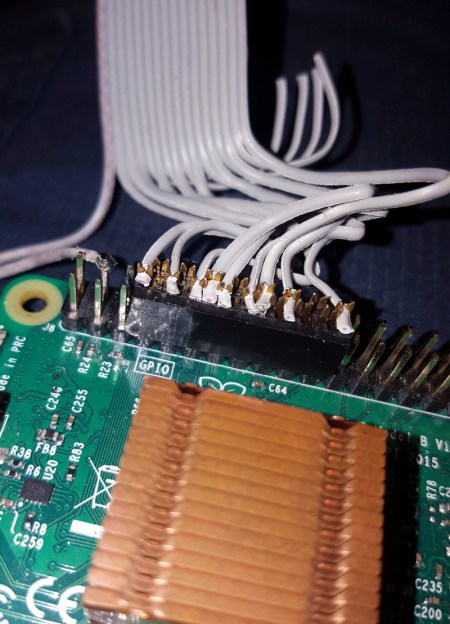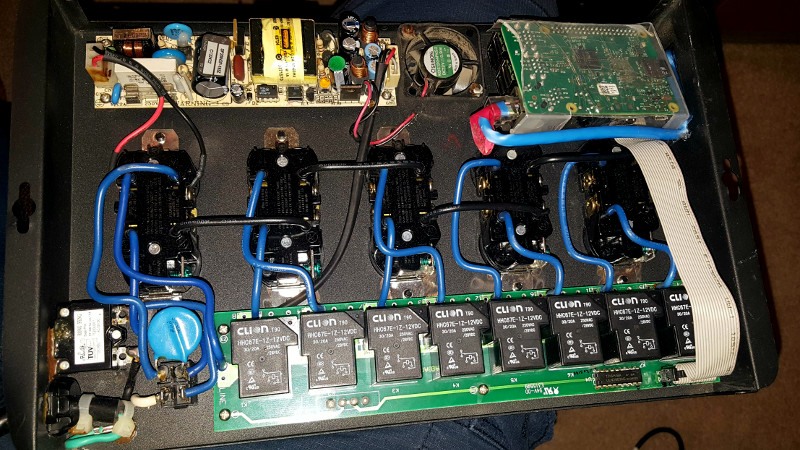We’re all for buying broken stuff from eBay to save yourself a few bucks: buy it cheap, fix it, and reap the rewards of being a step ahead of the average consumer. Searching through the “For parts or not working” categories is nearly the official pastime here at the Hackaday Bunker. But buying an eBay find only to have it give up the ghost in a couple weeks? That hurts.
 That’s precisely what happened to [idaresiwins] when he bought this beefy looking “Web Power Switch” on the Electronic Bay. After two weeks, the controller board blew and his “smart” power strip became very stupid indeed. But with the addition of a Raspberry Pi, he’s got it back up and running. Not only that, but given the extra horsepower this device now contains, it now doubles as a basic server for the home lab.
That’s precisely what happened to [idaresiwins] when he bought this beefy looking “Web Power Switch” on the Electronic Bay. After two weeks, the controller board blew and his “smart” power strip became very stupid indeed. But with the addition of a Raspberry Pi, he’s got it back up and running. Not only that, but given the extra horsepower this device now contains, it now doubles as a basic server for the home lab.
This conversion was helped by the fact that the original controller was on a separate board from the relays, and connected with a small ribbon cable. All [idaresiwins] had to do was figure out which wire in the cable went to each of the eight relays, and fire them off with the Pi’s GPIO pins. In an interesting detail, he opened up one of the ends of the ribbon cable and used it as a punch down block of sorts to easily hook the wires up to the Pi’s pins. We might suggest some hot glue to keep everything from moving around, but otherwise it’s a neat tip.
[idaresiwins] found some information online about making a web-based GPIO interface, which he adapted to control the outlets on the power strip. He then wrapped the Pi up in plastic to keep it from shorting out, and tucked it inside the case. Note that he was able to pull 5 VDC from the relay board and run it to the Pi over the ribbon cable, so he didn’t need to bother with hacking a USB adapter in there.
Controlling AC devices over the Interwebs is an extremely popular project, and we’ve even seen a DIY device that looks quite similar to this product. Most of them are now using the ESP8266, but with the Pi onboard this hack is more like a super-sized version of the PowerPwn.

















Some extra hardware and some smarts maybe can give some info about what’s plugged into that strip.
Ubiquity mPower does just that, every outlet has current and voltage measurement so you can see on web interface or SSH terminal how much power each outlet uses. Very convenient to check if everyting is plugged properly and working.
I thought the mpower is basically abandoned at this point?
I started looking into the mfi gear and while it appears to still be sold (kinda) it isnt really supported anymore by Ubiquiti.
I would be thrilled to be wrong by the way, because I want to buy into the ecosystem. mpower looks like some pretty convenient gear, as well as the mfi power monitoring.
Check out growcomputer.io, we’re shipping units to beta customers now. Pre-order it at http://www.openagriculturesupply.com
Maybe replace the MOV as well if the board is that old don’t need a bunch of melted things
Wow, one needs to be brave to keep using a Chinese device connected to mains 24/7 that already blew up once ;-)
+1
Digital Logger Inc. – Santa Clara, CA. Made in USA.
So surprisingly not chinese!
Doh, in my eastern european part of the world eBay is virtually synonymous with cheap stuff from China, but I shouldn’t have assumed that here. My bad, please disregard the “Chinese” from my wise-ass comment.
No, we were all thinking it!
I think an arduino with a esp8266 or something would have been better here. That way you dont have to wait for your powerstrip to boot.
So I’m not the only one chopping up wall warts for 5V to my controllers?
Definitely not the only one. A few years ago the company I worked for bought 10 USB to 8 port RS-232 adapters. Each needed 12V power but to support this internationally they shipped each device with 4 different wall warts with various AC plug ends. We of course only needed one for each which meant we had 3 wall warts that went from 120-240VAC 50-60Hz to 12VDC for each of the 10 adapters we bought. Electrically they are all the same and just had a different plug molded on. Instead of throwing them out I took them for projects and will likely never need another 12V adapter. 5V on the other hand I’m always short on.
0. someone else also noted – the MOV es no buenos. At least sleeve that evil little thing in something rated V-0.
1. ground bond from ac mains cord es muy mal.
2. ground bounds for the AC receptacles tambien es muy malo.
3. the CB does not have an adequate rating per the standards that would be in the scope to this equipment (60950-1,62368-1, 60083, 60884-x,61643-x, and UL1363).
References
1. IEC/UL60950-1, annex Q
2. IEC61051-2
3. UL1449
4. IEC/UL62368-1, clause 5.5.2.8, annex G
5. comments on surge protective devices in IEC TC108 interpretation sheet, Doc No 441
6. NEC (NFPA70) article 250 – look at the expected impedances for a building’s grounding conductors. These impedances are generally worse in the EU, and in particular can be horrendous in the UK and Italy. Which is why the internal connection of the green wire to ac mains-connected equipment is important to do correctly.
6. 29CFR1910.303(b)(2) – OSHA regulation for workplace stuff that would apply to this.
If you’re into Alexa control – you could use mewo ( a nodejs implementation of Belkin’s wemo protocol) to control the gpios/the connected sockets. I use mewo to do HDMI CEC control on my TV. It’s been very reliable (over 2 years), as long as you pre-configure a port for each device, instead of letting it auto-assign them.
What is that heatsink on the Rpi?
This is dangerous maybe?
the “e” in “eBay” actually stand for “echo”.
I have build various multi channel timers out of pi’s and relay boards. This is not too expensive if you use the pi zeros with wireless and understand the relays are made in China and limit them to about 50% of what they are rated at. It is also a mistake to use a small micro usb supply to power the thing. The current the relays require to pull in adds up. I wrote a script to exercise the relays turning them on and off in sequence and with a random micro usb supply you can actually hear the difference in the “clicks” of the relays pulling in and watch the relay active LED’s dim out as more of the relays get turned on. The first few relays make a nice resounding click when it pulls in, the last one you can not even hear. Use beefier wire to the V+ and ground on the relay board and a 2.5A open frame switching power supply and you can not hear the difference between the first relay and the last relay. The one thing that surprised me was with the small supply, the relays did not cause an undervolt event and crash the pi. Given enough time I am pretty sure that would happen though. Or the little supply would fail. A lot depends on how many of the relays you have energized at the same time. My use would be never, but uses tend to change and best to be ready to deal with any situation.